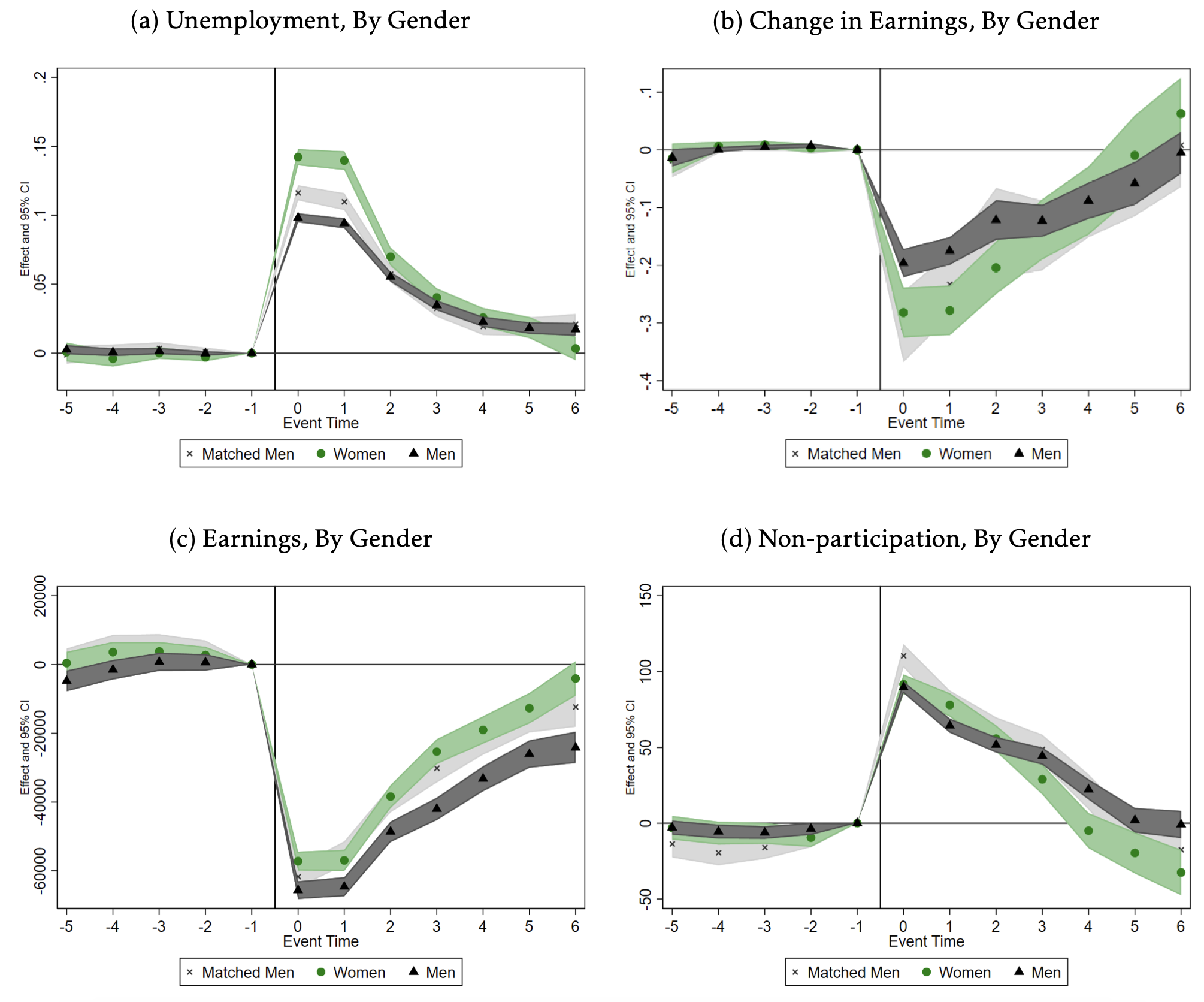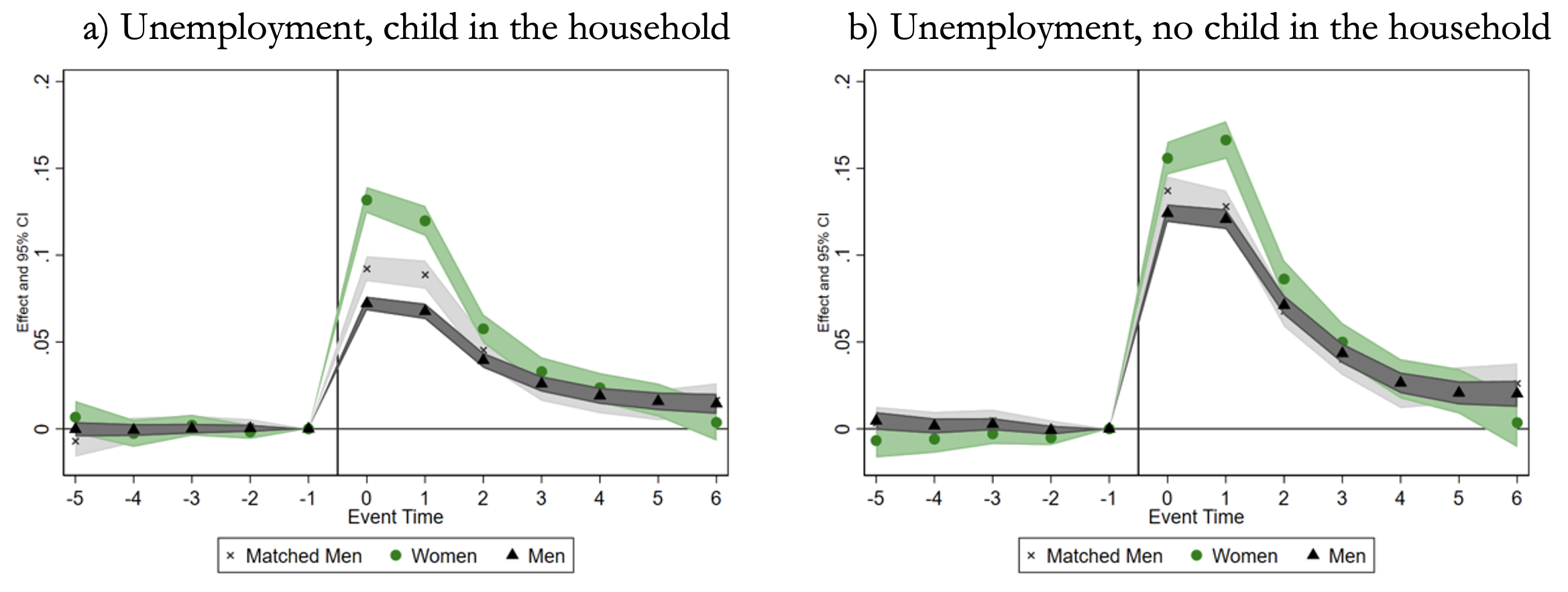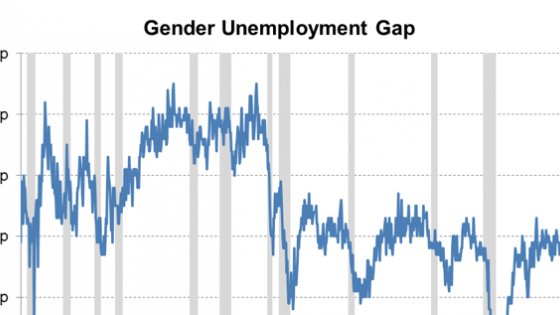A large firm is closing and dismissing all its workers. The firm employed both men and women. Will the consequences of the dismissal be different across genders? Or do men and women experience a similar path of income and employment recovery? If there are differences in their recovery, why do they occur? Existing research points to several reasons why men and women fare differently after losing a job. Gender differences in education, occupations, and other types of sorting is an important driver of the overall gender gap (Goldin 2014). Such differences might affect disparities in recovery. Moreover, gender differences in childcare responsibilities contribute substantially to gender gaps in middle and high-income countries (Kleven et al. 2019). Mothers may be more restricted than fathers when adjusting to labour market shocks.
Many workers become unemployed at some point during their lifetime, and research has shown that job loss can lead to persistently lower earnings and higher unemployment – at least for men. With more women working today than in the past, their risk of job loss has increased, yet we know little about gender differences in labour market recovery following job loss.
In a recent paper (Ivandic and Lassen 2023), we quantify the magnitude of gender gaps following job loss and disentangle the role of human capital and childcare for women’s adverse labour market outcomes. We find that women face a 40–45% greater risk of unemployment and lower earnings in the first two years after job loss. Gender differences in labour market experience and education explain less than half of the gap. The unequal division of childcare responsibility appears to play a key role in explaining the rest.
To reach this conclusion, we rely on employer-employee administrative data from Denmark over a decade to track the employment and earnings of individual workers. Beyond information on all employment relationships – matching workers to firms – we also observe background information on each individual, such as their labour market experience, education, and family characteristics. This allows us not only to estimate gender gaps following displacement, but also to determine how much of the gap is linked to child-related factors and how much to differences in labour market experience. Our research design uses plant closures that triggered job losses to establish causality using an event study framework. We compare the evolution in the displaced workers’ earnings, risk of unemployment, and non-participation to similar workers of the same gender, matched on sociodemographic characteristics, who were employed in a plant that did not close. Our identifying assumption of the displacement effect is that the labour market outcomes of the individuals in the displacement and control groups would have evolved similarly over time had they not lost their job to a plant closure.
Figure 1 Following job displacement, workers see a rise in unemployment and a fall in earnings, and a gender gap emerges
Note: Job displacement occurs between -1 and 0, marked by the vertical black line. Black triangles denote displaced men while green circles denote displaced women, each relative to a control group of workers of the same gender who were not displaced. The light grey crosses show effects for displaced men that on average have similar observable characteristics as the sample of women. The outcome in Panel A represents the likelihood of claiming unemployment benefits for at least three months in a calendar year. The outcome in Panel B represents the proportional change in earnings relative to the period 2–4 years before job displacement, while the outcome in Panel C represents the change in absolute earnings (Danish krone) relative to the year before job displacement. Panel D reports a measure of the fraction of the year spent neither working nor registered as unemployed.
Gender gaps in employment and earnings after job loss
The gender gaps in the labour market recovery after a job loss (visualised as the difference between the black and green lines) are depicted in Figure 1. In line with a large literature, we document that displaced workers face an increased risk of unemployment (Panel A) and a reduction in earnings (Panel B) for several years (e.g. Jacobsen et al. 1994, Bertheau et al. forthcoming). Women on average experience a 14.2 percentage point increase in the probability of unemployment over the first two years, while for men this increase is smaller, at 9.8 percentage points. This difference amounts to a relative gender gap of 5.4 percentage points, or 45% in the risk of unemployment. This gap shrinks over time and closes four years after job displacement.
Women also experience a larger relative loss in earnings (Panel B). In the first year after job displacement, the gender gap in earnings loss is 44%, as men lose on average 19.6% of their earnings while women lose 28.2% of theirs. In the fourth year following displacement, the gender gap disappears. As shown in Panel D, we do not find a gender gap in labour force participation after a plant closing.
A potential source of these gender gaps could be differences in human capital, broadly defined to include education, experience, occupation, and other types of sorting in the labour market. In our sample, women are less likely to hold a vocational diploma or a university degree than men, and they earn less prior to the job loss. To account for gender differences in such characteristics, we construct a new sample of men who are similar to the women on relevant labour market and socio-economic characteristics prior to displacement. This allows us to compute the conditional gender gap that accounts for these differences. When we compare men and women with similar characteristics, shown as the grey line in Figure 1, we find that gender gaps are smaller but the majority of the gaps remain.
Figure 2 Gender gaps following job displacement are larger when children are in the household
Note: See note to Figure 1.
The presence of children helps explain the gender gap
While men and women are equally likely to be parents, we show that the impact of children on unemployment and earnings after job displacement is different. As depicted in Figure 2, Panel A, job displacement in the presence of children increases the risk of unemployment by an average of seven percentage points for men and 12 percentage points for women in the first two years of displacement. This leads to a relative gender gap of 80% in the risk of unemployment in the presence of children. In households without children, shown in Panel B, job displacement increases the risk of unemployment by 12 percentage points for men and 16 percentage points for women in the first two years of displacement, a relative gender gap of 33%. Hence, our estimates show that the gender gap in unemployment risk is more than twice as large when the worker has children, from 33% in households without children (Panel B) to 80% in households with children (Panel A). Because other characteristics might influence the gender gap, we use a decomposition technique to understand how much individual and household factors matter.
Specifically, we examine the importance of human capital, such as formal education and cumulative work experience, as well as the different ages of children – from preschool, to primary school age, to teenagers. We find that gender differences in human capital can explain one-third of the gap in unemployment and two-thirds of the gap in earnings, with differences in pre-displacement earnings and education being the most important factors. Having children increases the gender gap following job loss regardless of the mothers’ experience, earnings, and education.
Preschool children have the biggest impact on the gender gap, while the presence of teenagers hardly matters. If men and women were equally affected by the presence of young children, the gender gap in earnings would be half as large, and the gender gap in employment would be one-third smaller. In contrast, gender differences in sorting across plants, firms, and industries do not affect the gender gap in unemployment following displacement.
Women suffer greater risks of unemployment and earnings loss after job displacement than do men. While there is ample evidence on the long-term negative effects following job loss, women are often excluded from the analysis. This striking gap in the literature implies that policy recommendations are not based on relevant estimates. For example, while the most exposed workers during the Covid-19 pandemic were women (Alon et al. 2020), there is a lack of existing evidence on how their future labour market participation will be impacted and what would mitigate their recovery. Our estimates show that appraisals based solely on male workers are substantially biased towards zero. Moreover, disentangling the role of labour market experience from that of children in the gender differences in earnings and risk of unemployment as a result of a job loss can help us understand the persistent gender inequality associated with children (Kleven et al. 2019). The responsibility of childcare falling disproportionately on women imposes a barrier to labour market recovery and prevents women’s adjustment to labour market shocks.
References
Bertheau, A, E Acabbi, C Barceló, A Gulyas, S Lombardi and R Saggio (2022), “The unequal cost of job loss across countries”, American Economic Review: Insights, forthcoming.
Alon, T, M Doepke, J Olmstead-Rumsey and M Tertilt (2020), “The impact of the coronavirus pandemic on gender equality”, VoxEU.org, 19 April.
Goldin, C (2014), “A Grand Gender Convergence: Its Last Chapter”, American Economic Review 104(4): 1091–119.
Ivandic, R and A Lassen (2023), “Gender gaps from labor market shock”, Labour Economics 83, 102394.
Jacobson, L S, R J LaLonde and D G Sullivan (1993), “Earnings Losses of Displaced Workers”, American Economic Review 83(4): 685–709.
Kleven, H, C Landais, J Posch, A Steinhauer and J Zweimüller (2019b), “Child penalties across countries: Evidence and explanations”, American Economic Association: Papers and Proceedings 109: 122–26.





